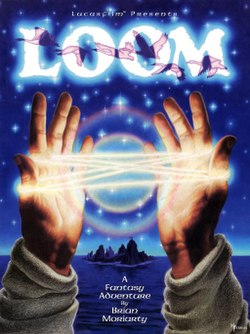Loom (video game)
| Loom | |
|---|---|

Cover art by Mark Ferrari
|
|
| Developer(s) |
|
| Publisher(s) |
Lucasfilm Games
|
| Designer(s) | Brian Moriarty |
| Artist(s) |
|
| Composer(s) |
|
| Engine | SCUMM |
| Platform(s) | DOS, Mac OS, Amiga, Atari ST, FM Towns, TurboGrafx-CD, Windows |
| Release date(s) | |
| Genre(s) | Graphic adventure |
| Mode(s) | Single player |
Loom is a 1990 fantasy-themed graphic adventure game by Lucasfilm Games. The project was led by Brian Moriarty, a former Infocom employee and author of classic text adventures Wishbringer (1985), Trinity (1986), and Beyond Zork (1987). It was the fourth game to use the SCUMM adventure game engine, and the first of those to avoid the verb–object interface introduced in Maniac Mansion.
A departure from other Lucasfilm adventure games in many senses, Loom is based on a serious and complex fantasy story. With its experimental interface, it eschewed the traditional paradigm of graphical adventures, where puzzles usually involve interactions between the game character, the environment, and items the character has in their possession.
Loom's gameplay centers instead around magical four-note tunes known as "drafts" that the protagonist, Bobbin Threadbare, can play on his distaff. Each draft is a spell that has an effect of a certain type, such as "Opening" or "Night Vision." Some drafts can be reversed by playing their notes backwards, so the "Dye" draft played backwards becomes "Bleach," while others, such as the "Terror" draft, are palindromes (e.g. C–E–E–C) and so cannot be reversed in this manner.
Bobbin can learn drafts by observing an object that possesses the qualities of the desired draft; for example, by examining a blade while it is being sharpened, Bobbin can learn the "Sharpening" draft. When the game begins, Bobbin is only able to play drafts using the notes C, D and E, limiting his ability to reproduce more powerful drafts. As the game progresses and additional notes become available, so his ability to play new drafts increases.
...
Wikipedia
